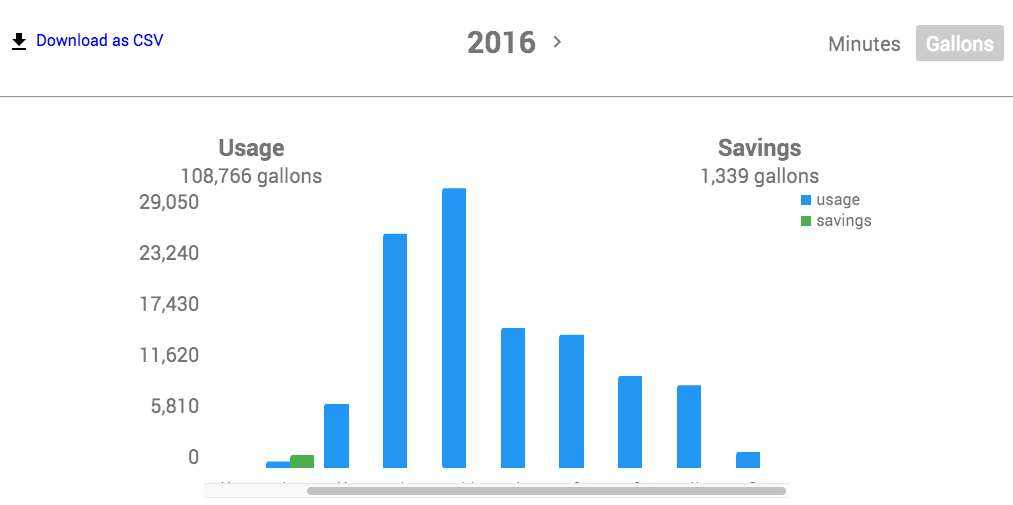Is there any chance that you’d be able to share anything yet? 
When I have some tangible features I’ll try to share screenshots/functionality.
Just know that we are rebuilding iOS/Android/Webapp and our cloud platform.
We hope to be releasing features never before seen for an irrigation controller  .
.
The platform we are building, once finished, is going to allow us to release new features every few weeks and do some very amazing things.
I know this is vague, but I always get in trouble when promising exact features we are delivering until fully built.

What is the status on Gen 3
Team is still cranking away at v3 of our software, huge undertaking but will put us in a great position for the next 5 years.
We will call out for beta customers when we have a minimum viable beta, and then once ready we will deliver to our regular customer base.
I can’t give dates or features yet since those always seems to get me in trouble 

Just wondering, is it possible in the future that ET data will be gathered from higher end PWS (commonly made by Davis Instruments) that have soil moisture sensors and calculate ET on their own? I’m currently using a hyperlocal highly accurate PWS near me with NIST-traceable sensors (includes soil moisture sensors, too). What sources of data are presently used for calculating those long ET equations if I’m using a PWS?
Here’s the PWS I’m using http://www.pwsweather.com/obs/KC6MLR.html
It looks like Rachio’s weather provider isn’t providing ET data (even if the PWS itself has it calculated and can be accessed). I did read somewhere that Weather Underground developers are making the ability for PWS to display ET data a priority for 2017 (but I’m not sure if WU is going to calculate it or they’ll pull ET data from PWS that calculate it). Of course I understand adding WU would be another licensing fee for Rachio.
Based on weather inputs we use the Penman Monteith equation.
http://www.fao.org/docrep/X0490E/X0490E00.htm
Would be glad to use a derived ET value if provided to us.

Except I don’t believe the Iro2’s calculation for ‘Crop Evapotranspiration (-)’ is affected by temperature or crop season. Hopefully enhancements to arrive with Iro3.
Best regards,
Bill
@a0128958, our scheduling inputs are the same for both Gen1s and Gen2s. The calculation does account for temperature. The crop season is currently static and can be edited within the advanced zone settings menu. If your Flex Daily schedule was created before May 2016, the crop coefficient dynamically changes on a month to month basis.
It was hard for me to see less watering in cold months than in hot months, all else being the same (wind, humidity, insolation, rain). I’ll keep looking for the affect of lower temp / less water - all else the same.
If in full automatic mode, which is focused on maintaining soil saturation at or above 50% (for example) by zone, it would seem that you’d have to put down the same amount of water in November than in July, all else the same (wind, humidity, insolation, rain). It surprises me that you’re saying that the calculation of ‘Crop Evapotranspirationn (-)’ is adjusted by ambient temperature.
Best regards,
Bill
@a0128958, thanks for confirming. I reviewed your account and I’m seeing a decrease in water usage during the winter months – here’s a screenshot of your water use month over month for 2016 (July is the peak watering month @ 29K gallons):
If you haven’t already, check out this support article to see how you can download the data we use to create these graphs.
Let me know if I’m misunderstanding your question. As I’m sure you already know, the watering durations don’t change on Flex Daily schedules, only the watering interval on a zone by zone basis. Also, we don’t currently record any “savings” with Flex Daily schedules since the watering events are not skipped, but simply delayed and rescheduled to supplement mother nature.
I understand most of this. Thank you.
I wasn’t seeing very aggressive watering reduction as the winter months arrived, due mostly I believed to ambient temperature and crop growing season parameters not being used for Iro2’s calculation for ‘Crop Evapotranspiration (-)’ (while being mindful of how other factors, such as rainfall, can substantially influence the subject).
Your chart (thank you) shows this, with the exception of the last month. In this case, I just gave up, put the controller into manual mode, where it has remained for a while. It’s also why I stopped posting the monthly summary commentaries.
IMO, given the update here, your algorithm for computing daily adjustments to ‘Crop Evapotranspiration (-)’ is not as aggressive as it could be toward putting down the least amount of water in a fully automated manner in winter months for the Dallas climate.
Parks and commercial entities are thus going to use more water in Winter months than they need to with your product. IMO.
Best regards,
Bill
I am experiencing the same issue. I had to manually fill all my zones because during the colder days in January when the grass was still dormant my sprinkler system was still going off at least twice a week in Central Texas. Before I knew it I saturated my lawn and turned my neighbors into a marsh all while trying to water dormant grass in completely saturated soil. This goes against the ease of use that the Iro is marketed. It seems I spend more time fiddling with my Iro2 than my old manual system.
I also was experiencing watering and over-saturation here in San Jose CA when we are experiencing 100 year rain cycle. Some more aggressive adjustments clearly need to be done on the slope of the ET equations. During normal years I rarely water between mid November and mid February at all and this year is many times that wet. I eventually turned the unit off (standby). One issue seems to be the lack of duration variation throughout the year for flex daily during the year. if that had a 20:1 variation, the system might not panic that the ET rate would go under a threshold so easily. Just a thought.
Another V3 winter/rain thought that could use some improvement is the need for a new variable for rain effectiveness which mainly effects discrete dripper setups. When it rains a larger ratio of the ground is wetted than during an irrigation event. Perhaps 2x multiplier. Lawn sprinklers would be largely unaffected by this ratio (100%), as the rain area equals the irrigation area (although the uniformity would be higher 100% vs 70% or so for normal sprinklers, so this could help with that adjustment)…
Interesting ideas. I’m trying to visualize this through software. My fear (which is mostly realized) is when we have normal or less than normal years without this amount of significant rainfall.
Thoughts on a better way to track super saturation but not let it water too little? There are a lot of dynamics that we try to track, but I agree probably a better way to track massive amounts of rain.
![]()
@franz I will continue to think about this complex adjustment topic. My first thoughts are around a non-linear affect to water/root depth. If there is a ton of water 24 inches down, it does not necessarily mean that there is water in the first 4 inches if the sun pops out for shallow roots, but almost for sure the ground 8 inches down and further will always be close to saturation, likely above maximum desired. A few hours after adding an inch of water will have no affect on the soil below 8 inches unless it is sand down further than a few feet. Saturated is saturated. Supersaturation would seem to have a depth, like the depth of the cleche layer in some soils. Until conditions cause that layer to dry, there will likely be a range of wetness above it (non-linear). Sometimes going manual for a while is 100x easier than trying to automate it.
@a0128958, We agree – dynamic crop coefficients would help with seasonal demands on watering.
@bugs30, I reviewed your zone settings and it appears your root zone depths are currently set to 4" – we recommend a 9" root zone depth for warm season grasses. Changing your root zones to the 9" target would more than double to intervals between waterings.
@bug99, Flex Daily schedules are designed to manage soil moisture balance, as such, the duration should not change since your “water tank” does not change in size from season to season.
One of the difficulties in working with rainfall is estimating the fraction of total rainfall that is actually stored in the root zone; this is know as effective rainfall in the irrigation world. Small amounts of rain water usually do not reach the soil because it it held in the mulch or thatch. Some rain water mat percolate below the root zone and become unavailable. Additionally, depending on the intensity and duration of the rainfall event, runoff can occur and not be effective.
We’re exploring new saturation limits to help address this issue.
I totally agree. When teasing out solutions, i recommend keeping a least these two items in mind.
- super saturated soil brings water up from below the root zone through capillary action. This is the hard nut to crack without extra data from a sensor or service.
- small to medium amounts of rain in the non-wet season will wet 100% of the soil in the first inch (assuming no runoff), vs drip which is a much smaller fraction, growing in a cone shaped by the soil type to some depth. If all of the roots are in the wetted cone, the areas / efficiency are about the same. This might be the case for a mature plant with deep roots. This issue is not as hard to solve, but is also less important, especially for grass zones.
I am not convinced that this is true. If we treat the sub root zone moisture and the moisture that is outside of the cones of the drip system as a second tank feeding the primary tank, the size of the tank effectively increases during the wet season. Perhaps knowing something about this from the weather service will allow the tank size to slowly vary to help fix this super saturation issue. Thoughts?
@bugs30, I reviewed your zone settings and it appears your root zone depths are currently set to 4" – we recommend a 9" root zone depth for warm season grasses. Changing your root zones to the 9" target would more than double to intervals between waterings.
@emil If I did that I would set my root depth far deeper than my roots which are currently at 5-6" as measured. This grass was sodded two years ago. I already have problems with the grass being too dry during the summer and this would make it worse. That’s the issue. It’s too dry during the summer and too wet during the winter when the grass doesn’t grow.
Wouldn’t supporting soil moisture sensors be a better way to support this? Instead of estimating get the actual moisture. Quite possibly even get the moisture at different levels for a complete picture of saturation. Some sensors even work as a mesh so distance from the Iro wouldn’t matter as they would pass the signal from one to another. This seems a lot simpler and far more accurate method.

